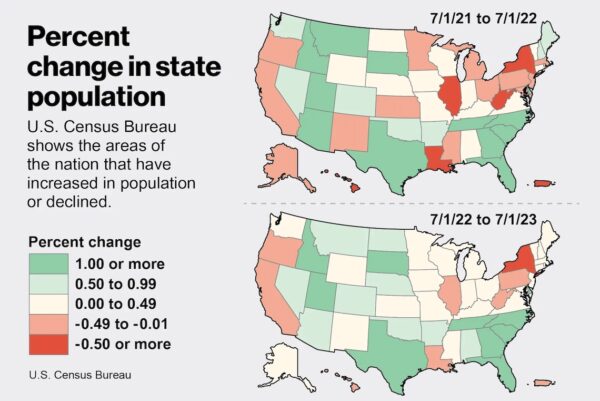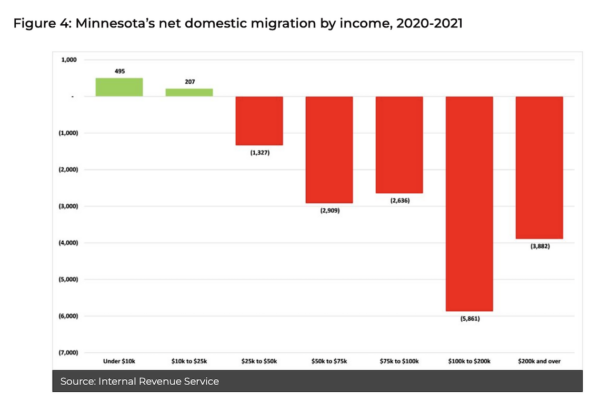It has been obvious for quite a while that Americans are deserting blue states in favor of red states. Thus, after the last census states like California and New York lost seats in the House, while states like Florida and Texas gained seats. Just-released census data show that migration from blue to red continues. The New York Post focuses, naturally, on New York:
New York’s population plunged more than any other state in the country over the past year, according to sobering new statistics – as fed-up lawmakers and ex-New Yorkers blame crime and the sky-high cost of living.
Almost 102,000 people fled the Empire State from July 2022 to July 2023, the United States Census Bureau revealed in a Tuesday report.
It was one of eight states to face a net-decline in residents over the period, while red states, including Texas and Florida, saw the largest growth in population.
These maps, reflecting the last two years of Census Bureau data, show the pattern:

Blue states seem to be mostly in denial about what is happening:
When reached for comment, Hochul’s office referred The Post to a statement she made about “migration trends” as part of a Nov. 30 speech at a real estate conference.
“When you study out migration trends, like I do all the time, I’m looking at the states that people are going to,” she said last month. “OK, Florida. A little nicer weather. You got that, but that’s all you’ve got. That’s all you’ve got. But we’ve lost some people to Florida.”
The idea that Florida–a state with no income tax and much less crime than New York–has nothing to commend it but weather, is delusional. But you don’t see Gavin Newsom talking about cutting taxes, either.
Then there is Minnesota. California and New York get most of the press, but Minnesota is another blue state, like Illinois, that has been bleeding population to other states for quite a while. John Phelan writes about the Census Bureau’s most recent Minnesota numbers here.
But the census numbers don’t tell the whole story. There are two relevant data sets: one is generated by the Census Bureau, the other by the Internal Revenue Service. They use different methodology to measure slightly different things, but the main difference is that the IRS database includes demographic information about the people who move from state to state. So we know how old they are and, most relevantly, what their incomes are. Because the question isn’t just how many people are moving from place to place, it is also who is moving from place to place. Or equally important, who is not moving to blue states in the first place because that is not where the good jobs are.
The IRS data lag the Census Bureau numbers and aren’t produced every year, so they don’t get as much attention. But American Experiment has been analyzing them, as to Minnesota, since 2016. I don’t know whether policy organizations in other states have been doing the same thing. If so, I haven’t seen it. But the Minnesota IRS numbers are highly relevant, I think, to the broader picture of red/blue migration.
The IRS data consistently show that Minnesota, a high tax, high regulation state, gains residents from other states in just one income category: those earning between zero and $25,000 per year. Minnesota essentially breaks even from $25,000 to $50,000, and consistently loses residents, on a net basis, in every income category over $50,000. So we aren’t talking about “the rich.” This chart is similar to others we have produced over the years:

I suspect that if someone did this analysis for California, New York or Illinois, the result would be the same: Census data actually understate the depth of the economic and fiscal problems blue states are facing as a result of migration to more favorable jurisdictions. In the raw numbers, in-migration of people with essentially no income offsets, to some degree, out-migration of residents with good jobs. But in fact, gaining more residents with little or no income makes the economic position of blue states worse, not better.
As I said, these trends have been obvious for a while. When will blue states catch on? Not until the voters demand change. We have seen that Democratic office holders consistently try to deny the obvious, rather than doing anything about it. Liberal politicians will cling to power as long as voters let them get away with it.
Notice: All comments are subject to moderation. Our comments are intended to be a forum for civil discourse bearing on the subject under discussion. Commenters who stray beyond the bounds of civility or employ what we deem gratuitous vulgarity in a comment — including, but not limited to, “s***,” “f***,” “a*******,” or one of their many variants — will be banned without further notice in the sole discretion of the site moderator.